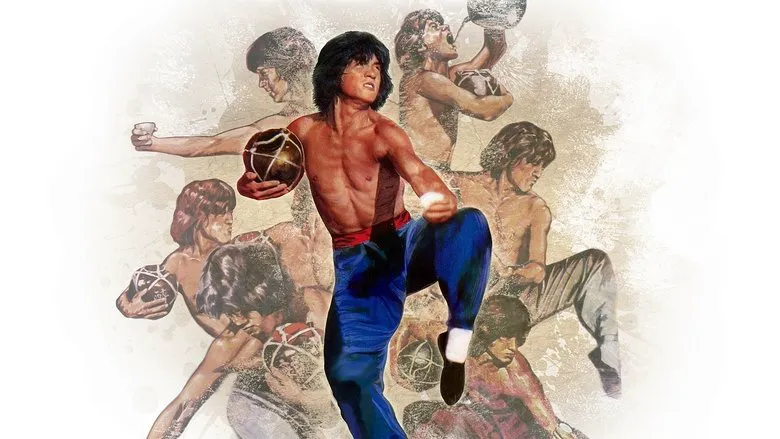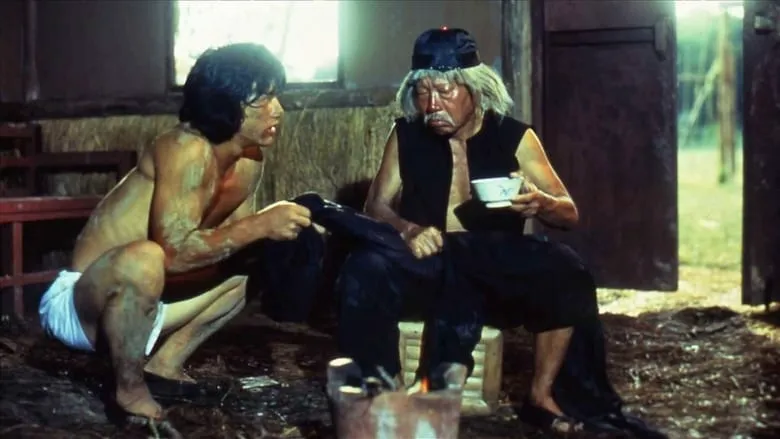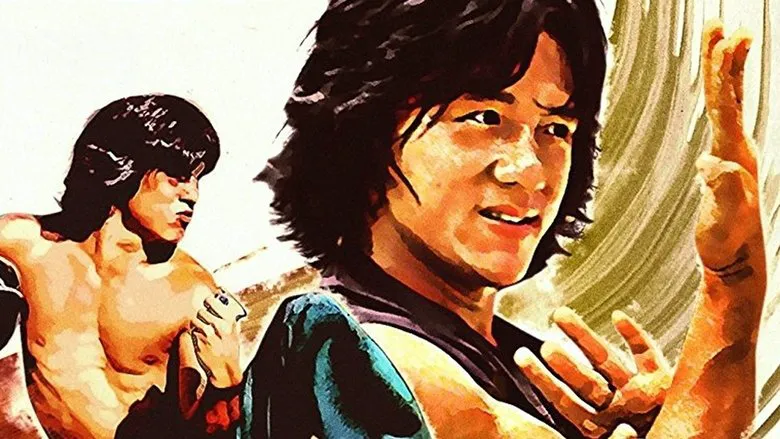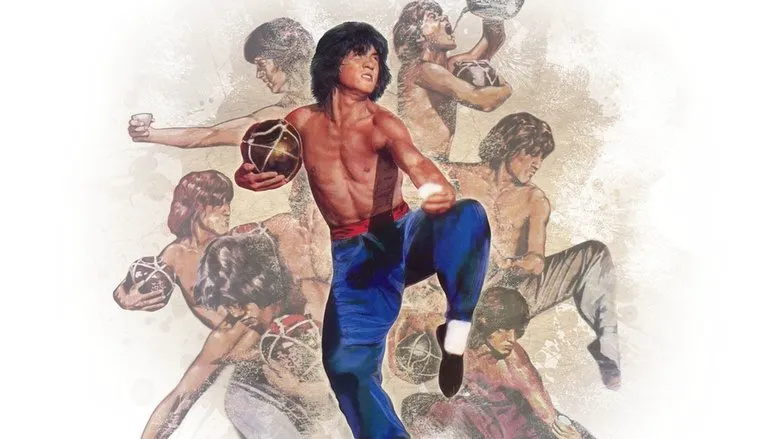From Snake Fist to Drunken Master: The Rise of Jackie Chan
In our previous installment, independent producer Ng See-yuen’s Seasonal Film Corporation secured Jackie Chan from Lo Wei Motion Picture Company. They also brought together a cast including veteran actor Yuen Siu-tien, Hwang Jang-lee (one of the “Four Great Legs”), and Shih Kien, a future boss of Cinema City and a popular leading man. This impressive lineup came together to create Snake in the Eagle’s Shadow.
 Poster of Snake in the Eagle’s Shadow
Poster of Snake in the Eagle’s Shadow
The film grossed HK$2.7 million, ranking eighth in the box office that year.
Snake in the Eagle’s Shadow is undeniably entertaining and well-made. However, its success is somewhat surprising upon closer examination.
A Familiar Framework
Firstly, the film’s structure isn’t particularly innovative. It largely follows the kung fu movie template established by Chang Cheh, even adopting his signature “revenge” plot. While the dramatic conflict is strong (arguably more so than in Drunken Master, thanks to a clear revenge narrative), other aspects are less remarkable.
The main plot revolves around the conflict between the Eagle Claw and Snake Fist styles. Initially, this seems promising, but upon closer inspection, the Eagle Claw clan is essentially the same faction from the earlier film Eagle Claw, Iron Body. Hwang Jang-lee even uses the same moves and fighting style.
 Hwang Jang-lee showcasing his Eagle Claw style
Hwang Jang-lee showcasing his Eagle Claw style
This realization can deflate the initial excitement and leave a mixed impression.
The Rise of Action Comedy
To be fair, the film is a straightforward action comedy. While action comedy elements weren’t entirely new, Snake in the Eagle’s Shadow, however, delves deeper into pure comedy. Yuen Woo-ping and Jackie Chan developed numerous flashy moves, brought to life by the veteran Yuen Siu-tien.
 Jackie Chan and Yuen Siu-tien in a comedic scene
Jackie Chan and Yuen Siu-tien in a comedic scene
Being their first attempt, the comedic elements weren’t fully integrated, but Jackie Chan’s physical prowess and Hwang Jang-lee’s refined Eagle Claw style compensated. Despite being Yuen Woo-ping’s directorial debut and a precursor to the “flashy” style, the action scenes were surprisingly hard-hitting. Reportedly, Jackie Chan even lost a tooth during filming. Despite the stylized choreography, the action retained a sense of power and authenticity.
Rumor has it that Jackie Chan also injured his eye, requiring medical treatment that resulted in a double eyelid. Comparing Jackie Chan’s appearance in To Kill with Intrigue with his look in the early scenes of Snake in the Eagle’s Shadow may offer some clues.
 Jackie Chan demonstrating a move
Jackie Chan demonstrating a move
The film also offered a glimpse into kung fu philosophy, with a specific mantra. Whether this was an original creation or a genuine martial arts secret remains unknown. Compared to Liu Chia-liang’s emphasis on both form and inner cultivation, this felt somewhat lacking. However, the absence of moralizing, while limiting its scope, allowed the action to take center stage, resonating with audiences.
The Success of Snake Fist
Ultimately, the film became a hit. Lo Wei was overjoyed, even though he only received HK$25,000 for the film. The increased exposure allowed him to sell Jackie Chan’s earlier, less successful films.
Then…
Ng See-yuen approached Lo Wei again, this time for a project called Drunken Master.
 Poster of Drunken Master
Poster of Drunken Master
The idea reportedly came to Ng See-yuen and Yuen Woo-ping while watching film distributors play a finger-guessing game at the Snake in the Eagle’s Shadow celebration party.
Lo Wei refused.
By this point, Jackie Chan’s rising star was undeniable. Lo Wei realized he could profit from Chan’s films himself, rather than renting him out for a small fee.
Jackie Chan was anxious
Thus, Drunken Master was greenlit.
The Making of Drunken Master
Due to the rushed pre-production, the basic structure of Drunken Master closely resembled Snake in the Eagle’s Shadow. This is a common characteristic of exploitation films: when a successful formula is found, it is often replicated.
However, despite the structural similarities, the details differed significantly.
 Jackie Chan in Drunken Master
Jackie Chan in Drunken Master
Firstly, Yuen Siu-tien played So Hua-chi, a master of Southern martial arts, also known as Beggar So. As a master of Southern Hung Gar, who would Jackie Chan play? Huang Fei-hung.
 Yuen Siu-tien as Beggar So
Yuen Siu-tien as Beggar So
This version of Huang Fei-hung is somewhat unconventional: mischievous, frivolous, and even a bit of a lecher.
Drunken Master incorporates some philosophical elements, with Chan’s character facing consequences for his mistakes. While his behavior might offend some Hung Gar practitioners, the film overall attempts to impart a moral lesson.
 Huang Fei-hung’s Drunken stance
Huang Fei-hung’s Drunken stance
The film’s main weakness lies in its action choreography, which lacks the innovation of Snake in the Eagle’s Shadow. While Snake in the Eagle’s Shadow clearly defined the Eagle Claw and Snake Fist styles, Drunken Master delays the introduction of Drunken Fist until the second half of the film, focusing instead on comedic antics. The narrative is also weaker than Snake in the Eagle’s Shadow, which had a clear revenge plot.
However, the action performance and acting in Drunken Master are superior. In Snake in the Eagle’s Shadow, Yuen Woo-ping’s influence was more apparent, with Jackie Chan simply executing the moves. In Drunken Master, Jackie Chan’s facial expressions are much more expressive and comedic.
It’s evident that Jackie Chan’s involvement increased significantly in Drunken Master. While audiences appreciated the novelty, few realized that this style would become a global phenomenon for decades to come.
The Authenticity of Drunken Fist
Unlike Snake Fist, which was a new style, Drunken Fist has roots in traditional martial arts.
In mainland China, Drunken Fist exists in both Northern and Southern styles.
Yuen Woo-ping learned the principles of Drunken Fist from a master in mainland China.
However, the moves in the film were redesigned by Yuen Woo-ping and Jackie Chan for aesthetic appeal.
The Eight Drunken Immortals’ mantras, in particular, added a layer of sophistication.
These mantras, combined with the carefully designed Drunken Fist moves, created the illusion of an authentic martial art.
Yuen Woo-ping’s version is more refined and poetic.
Regardless, the refined mantras and choreography in Yuen Woo-ping’s Drunken Master added significant cultural depth to the film, elevating it beyond a typical kung fu movie.
The Seeds of a Superstar
Jackie Chan was pleased with the film’s success.
Jackie Chan realized two things: 1. Kung fu comedy was popular, and he should continue in that direction. 2. He couldn’t let Lo Wei control his career.
As Drunken Master was being promoted, various forces began to compete for the rising star.
Ng See-yuen, having learned from his past mistakes, knew that Jackie Chan’s potential was limitless.
Soon, Raymond Chow of Golden Harvest approached him.